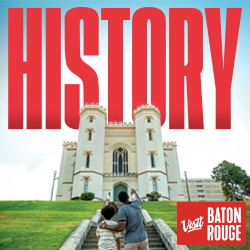You don’t have to look far to find evidence of Mexican influence in Texas.
Before it was the Lone Star State, Texas was part of Mexico. And the story of how Texas broke away, became a republic and eventually joined the Union is full of dramatic moments and fascinating characters.
Today, groups traveling around Texas can immerse themselves in the state’s colorful past at historic sites. Here are some places your group should visit to appreciate the people and places that made Texas what it is today.
San Agustin Plaza and San Agustin Cathedral
Laredo
Laredo’s historical downtown square, San Agustin Plaza, dates back to the city’s founding in 1755. It was used for public meetings and military exercises and was bordered by government buildings, San Agustin Cathedral and the homes of prominent residents. The plaza was considered the center of the Spanish Colonial town. Today, the plaza, which is the only 18th-century plaza in south Texas, is still the center of life in the city, hosting church festivals and patriotic events.
San Agustin Cathedral is the city’s oldest landmark, dating to 1756. The current church was built in 1872 on the site of two previous churches.
The Webb County Heritage Foundation offers a group tour that covers San Agustin Cathedral and its architecture that educates visitors on the history of Laredo, including the battles that took place when the city was part of the Mexican Republic. The foundation also offers self-guided tours through its website and will give tours of the nearby Republic of the Rio Grande Museum. The museum is in a beautifully restored house that was built in 1830 and was the home of Bartolome Garcia, a prominent rancher and mayor of Laredo. The building is a Texas Historical Landmark.
The Villa Antigua Border Heritage Museum is housed in a two-story brick building constructed in the early 20th century and was the home of two Laredo merchant families. The block it is on is full of historic properties and is immediately east of the cathedral.
Historic Mission Trail
El Paso
A visit to El Paso wouldn’t be complete without a tour of the Ysleta and Socorro missions and the San Elizario Presidio Chapel. The Ysleta Mission is the oldest continually active parish in the state of Texas, representing more than 300 years of Texas history. Built in 1682 by the Tigua Indian community, the historic landmark resides in the oldest community in Texas.
The Socorro Mission, a Franciscan mission founded in 1691, also has the distinction of being among the oldest continuously operated missions in the state. The current building was dedicated in 1843 and has 6-foot-thick adobe walls and massive vigas, exposed beams that project outside of the adobe walls and are characteristic of Pueblo and Spanish Colonial architecture. In 1789, the Spanish crown built the original San Elizario Presidio Chapel, choosing the site as a strategic military stronghold on New Spain’s western frontier to defend area residents from the Apache.
Visitors intrigued by El Paso’s deep cultural heritage come from all across the country to visit these beautiful missions. Groups interested in taking a tour can coordinate with Visit El Paso to see all three missions and the surrounding area, which is turning into a desirable arts community. Other highlights include the Tigua Indian Cultural Center of the Ysleta del Sur Pueblo — which includes a museum, the Cacique Café and Indian social dance performances every weekend — and one of the most exciting restaurants in Texas, El Charlatan, which offers a fusion twist on ramen and Mexican food.
San Jacinto Battleground State Historic Site
La Porte
On April 21, 1836, Gen. Sam Houston’s army of settlers, Tejanos and foreign volunteers managed to defeat Mexican General Santa Anna’s much larger army in an 18-minute battle. The following day, Santa Anna was captured and surrendered, ending the Texas Revolution. The San Jacinto Battleground State Historic Site commemorates that battle, preserving 1,300 acres with several different ecosystems, including tallgrass prairie, marshes and bottomland forest. Run by the Texas Historical Commission, the site is worth a visit for anyone interested in Texas history.
Group visitors can take a self-guided driving tour of the battlefield, hike the marsh trail or spend time exploring the 567-foot-tall San Jacinto Monument, which houses the San Jacinto Museum of History, a film about the Texas Revolution called Texas Forever and an elevator that takes guests up to an observation tower nearly 500 feet above the battlefield.
The museum has permanent and temporary exhibits about Texas history, including one on the building of the monument.
Today the site has 150 acres of parkland, with mown grass and picnic tables. The rest of the acreage is being restored to how it would have looked in the 1830s.
Tours for groups of up to 50 people take them past all of the significant points of the battle and relay real stories from the people who took part in the battle.
the Alamo
San Antonio
Located in downtown San Antonio, the Alamo was founded as a mission in 1718 and served as a way station between east Texas and Mexico. The Alamo earned its place in history decades after it closed its doors. In 1836, 200 Texans — including William B. Travis, James Bowie and David Crockett — held off Mexican Gen. Antonio López Santa Anna and 2,500 Mexican troops for 13 days during the state’s fight for independence from Mexico. The defenders eventually perished, but “Remember the Alamo” became a rallying cry for the Texas Revolution.
Today, visitors to the site can take interactive tours, view exhibits detailing the mission’s place in Texas history and visit a living history encampment where they can experience what frontier life was like in early Texas. Groups can organize a guided walking tour that explores the heroes and events that made the site famous. The tour takes them through the area that was the original footprint of the Spanish mission complex, today called Alamo Plaza.
The Victory or Death Audio Tour brings the story of the Alamo to life with sound effects, music and interviews with curators and historians.










